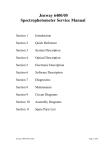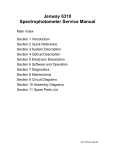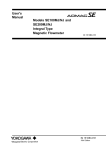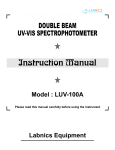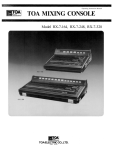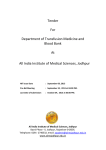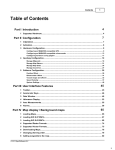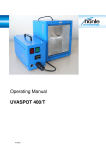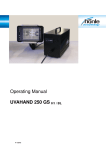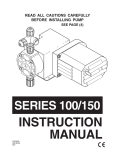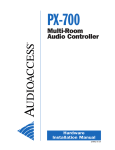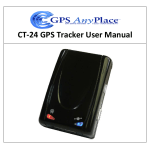Download Jenway 6300 Spectrophotometer Service Manual
Transcript
Jenway 6300 Spectrophotometer Service Manual Main Index Section 1 Introduction Section 2 Quick Reference Section 3 System Description Section 4 Optical Description Section 5 Electronic Description Section 6 Software and Operation Section 7 Diagnostics Section 8 Maintenance Section 9 Circuit Diagrams Section 10 Assembly Diagrams Section 11 Spare Parts List Jenway 6300 Ser Man 1 Section 1 Introduction 1.0 Index to Sections 1.1 About This Manual 1.2 Using This Manual 1.3 Warnings & Safe Practice 1.4 Standards & Certification 1.5 Ordering Spares 1.6 Returning Items 1.7 Contacting Jenway Limited Jenway 6300 Ser Man 2 Introduction. 1.0 Index to Sections Section 1 – Introduction 1.0 1.1 1.2 1.3 1.4 1.5 1.6 1.7 Index to Sections About This Manual Using This Manual Warnings & Safe Practice Standards & Certification Ordering Spares Returning Items Contacting Jenway Limited Section 2 - Quick Reference 2.0 2.1 2.2 2.3 2.4 2.5 2.6 2.7 About ‘Quick Reference’ Specification Main Sub-Assemblies Power Supply Voltages Signal Levels Error Codes Special Key Functions Test Solutions Section 3 - System Description 3.1 3.2 3.3 3.4 Background Sub-Assemblies Accessories Outputs Section 4 - Optical Description 4.1 4.2 4.3 4.4 Light source Grating Shutter and Filter Signal Detector Jenway 6300 Ser Man 3 Section 5 - Electronic Description 5.1 5.2 5.3 Power Supplies Detector Circuit Microprocessor and Display Section 6 - Software and Operation 6.0 6.1 6.2 6.3 Warning Start Up Routine Photometrics Concentration Section 7 – Diagnostics 7.1 7.2 7.3 7.4 Diagnostics Mode Shutter and Filter Control Lamp Control Zero Order Calibration. Section 8 – Maintenance 8.1 8.2 8.3 8.4 8.5 8.6 8.7 8.8 Routine Maintenance Dismantling Optical Alignment Energy Levels Wavelength Calibration A to D Calibration D to A Calibration Performance Verification Jenway 6300 Ser Man 4 Section 9 - Circuit Diagrams 9.1 9.2 9.3 9.4 9.5 9.6 Supply Schematic 630 504 Power Supply Layout 630 504 Detector PCB Schematic 630 506 Detector PCB Layout 630 506 Microprocessor PCB Schematic 630 013 Microprocessor PCB Layout 630 013 Section 10 - Assembly Diagrams 10.1 10.2 10.3 10.4 10.5 6300 Final Assembly 630 503 6300 Lower Case Assembly 630 510 6300 Top Case Assembly 630 010 6300 Optics Assembly 630 508 6300 Rear Panel Assembly 630 012 Section 11 – Spare Parts List 11.01 11.02 11.03 11.04 11.05 11.06 11.07 11.08 11.09 Packed Instrument Top Case Assembly Microprocessor/display PCB Lower Case Assembly Lamp Housing Assembly Monochromator Assembly Detector PCB Power Supply PCB Rear Panel Assembly Jenway 6300 Ser Man 5 1.1 About This Manual This manual covers the service, maintenance, calibration and repair of the Jenway Ltd model 6300 Spectrophotometer. (From serial number 5000 upwards, for lower numbers please refer to 6300 Mk1 Manual) This manual must be used in conjunction with the Instruction Manual for this model, as many of the routine maintenance procedures detailed in the Instruction Manual are not repeated in this Service Manual. 1.2 Using This Manual This manual is only for the use of Engineers and Technicians who have successfully completed a Jenway Ltd approved Service Training course on the Model 6300 Spectrophotometer. Updates to this manual will be circulated through the Jenway Ltd TSI (Technical Service Information) systems and to other registered users of this manual. Please complete the form at the rear of this manual to register your copy for future updates. In practice Section 2 - Quick Reference and Section 8 – Maintenance, with the Diagrams in Section 9 and 10, will be most frequently used, however it is good practice to read the complete manual initially and review it again periodically. To find the information required refer to the Main Index or Index to Sections to identify the relevant Section/page number required. 1.3 Warnings & Safe Practice Always disconnect the mains supply when any covers are removed as there are voltages present inside the unit that pose the risk of electric shock at levels that are hazardous to life! Do not look directly at the light source or allow the light beam to fall directly on the eyes, switch off or dim the lamp (as described in Jenway 6300 Ser Man 6 the procedures) whenever possible and wear eye protection at ALL times. The lamp gets very hot when in use, always allow time for it to cool down before removal. Always wear cotton gloves when removing a faulty lamp and replacing with a new one. Finger marks, dust and condensation can quickly destroy sensitive and expensive optical components, always wear cotton gloves when the optical bench is uncovered and handle any components by their edges only. Never touch optical surfaces. Do not remove optical covers unless the unit is in a clean, dust and condensation free environment. Many of the reagents, solutions and standards used for maintenance and calibration are corrosive or hazardous, ensure all precautions supplied with them are followed, where there is any doubt request a MSDS (Material Safety Data Sheet) from the supplier. This instrument can be used for analysing a broad range of samples, do not handle them unless you are qualified to do so. Ensure that the instrument has been correctly decontaminated before working on it, specifically in areas where the instrument may have been used for clinical, biological, corrosive or radioactive samples. 1.4 Standards & Certification No adjustments should be made to this instrument unless the test and measurement equipment, signal source or filters to be used have a current calibration certificate that is traceable to national or international standards and that it is known that this test equipment is currently performing to the certified standards. All solutions and reagents should be fresh and within any stated shelf life with a certificate of analysis. 1.5 Ordering Spares When ordering spare parts as detailed in this manual please quote the Part Number and Description. These items should be ordered from the original supplier of the equipment or your local Jenway Limited Distributor. Jenway 6300 Ser Man 7 1.6 Returning Items Should it be necessary to return any item for any reason then this should be done through the original supplier of the equipment or your local Jenway Limited Distributor. 1.7 Contacting Jenway Limited Before contacting Jenway Limited please check our web pages for any information or updates that may be helpful to you. www.jenway.com Emails should be sent to [email protected] Fax: +44 1371 821083 Phone: +44 1371 820122 Please note no items can be returned to (or will be accepted by) Jenway Limited without a Returns Authorisation number (RA number) and a completed Safety Clearance and Decontamination certificate. Jenway 6300 Ser Man 8 Section 2 Quick Reference 2.0 About ‘Quick Reference’ 2.1 Specification 2.2 Main Sub-Assemblies 2.3 Power Supply Voltages 2.4 Signal Levels 2.5 Error Codes 2.6 Special Key Functions 2.7 Test Solutions Jenway 6300 Ser Man 9 2.0 About ‘Quick Reference’ This section contains a selection of the key information that is often forgotten or difficult to find when required. Use Quick Reference as a memory jogger, but for more information check out the references to the main sections on each point. 2.1 Specification Also see Section 1.2 of the Instruction Manual. Wavelength Range Wavelength Resolution Wavelength Accuracy Spectral Bandwidth Light Source Optics Transmittance Absorbance Concentration Factor Photometric Accuracy Photometric Noise Stray Light Photometric Stability Readout Outputs Supply Voltages Power Dimensions Weight Jenway 6300 Ser Man 320nm to 1000nm 1nm +/-2nm 8.0nm Tungsten Halogen Single Beam Range; 0 to 199.9% Resolution; 0.1% Range; -0.300A to 1.999A Resolution; 0.001A Range; -300 to 1999 Resolution; 0.1, 1 Units; ppm, mgl-1, gl-1, M, %, blank. 0 to 999.9 / 1000 to 9999 +/-1% Less than 1% Less than 0.5%T Better than 1% per Hour (after warm up) Custom LCD Analogue (0 to 1999mV) & RS232 Serial 115/230 V a.c. Less than 50W 365 (w) x 272 (d) x 160 (h) mm 6Kg 10 2.2 Main Sub-Assemblies Also see Section 11 – Spare Parts 630 010 Top Case Assembly – includes the following… 630 025 630 013 630 510 Lower case Assembly – includes the following… 630 508 630 504 630 506 060 311 010 040 630 508 Tungsten Halogen lamp 12V Solenoid IR Filter Rear Panel Assembly – includes the following… 016 021 017 050 009 123 Jenway 6300 Ser Man Optics Assembly Power Supply PCB Detector PCB Cooling Fan Torroidal Transformer Optics Assembly – includes the following… 012 075 032 005 630 516 630 012 Keypad Display PCB 2A Fuse 20 x 5mm Mains Switch Mains Input Socket 11 2.3 Power Supply Voltages Also see Section 9 - Circuit Diagrams Before commencing more complex fault finding it is important to check all the internally generated supply voltages are correct. The following list is a useful guide to help quickly check these are functioning correctly. Not all the points where these voltages can be measured are given and where the voltage is stated as unregulated variations may occur. In general regulated supplies should vary by no more than +/-5% from their nominal value. Tungsten Lamp Supply, 12V dc regulated and set by VR1, measure at SK9 pin 5 with respect to SK9 pin 6 on the power supply PCB and at the terminals on the lamp base with the lamp fitted. Solenoid and Fan Supplies, 12V dc regulated and pre-set, measure at SK1 pin 1 with respect to SK1 pin 2 on the power supply PCB and on the solenoid and fan terminals. Digital Supply, 5V dc regulated and pre-set, measure at SK5 pin 1 with respect to SK5 pin 2 or on SK1 pin 1 with respect to SK1 pin 2 on the Display PCB. Stepper Motor Drive, 30V dc unregulated, also acts as unregulated supply for lamp, solenoid and fan supplies, measure between Star1 and Star 2 on power supply PCB. DAC Supply, +/- 10V dc supplies. +10V dc generated on the RS232 Interface, IC101, on the Display PCB, measure between pins 2 (positive) and 15 (0V) on IC101 on the Display PCB. -10V dc generated on the RS232 Interface, IC101, on the Display PCB, measure between pins 8 (negative) and 15 (0V) on IC101 on the Display PCB. Jenway 6300 Ser Man 12 2.4 Signal Levels Also see Section 7.2 - Shutter and Filter and 8.3 – Energy Levels All analogue signal processing is dealt with on the Detector PCB. The output from the detector is shown in the Diagnostics mode as a Voltage, in mV. For more information see Section 5.2 - Detector Circuit and Section 7.1 – The Diagnostics Mode. This voltage display can be used to check lamp energy (ageing), the correct functioning of the IR Stray Light filter as well as the Dark Shutter. 320nm Energy, In the Diagnostics Mode (see Section 7.1 Diagnostics Mode) set the wavelength to 320nm, close the Dark Shutter by pressing the right arrow key. Allow the mV reading to stabilise and record the stable value. Open the dark shutter by pressing the right arrow key and the mV reading must increase by more than 4mV from that recorded above. If not the lamp should be changed, if it still has not improved then the condition and alignment of the optical components should be checked. Dark Current, Set wavelength to 320nm, Dark Shutter closed, IR stray light filter closed, Voltage Display should be zero +/- 6mV. If not and no light leaks are obvious (damaged seals around sample chamber, lid not closing fully, damaged or poorly fitted casework etc) then the detector or detector PCB may be faulty. 720nm Output, Set wavelength to 720nm, Dark Shutter open, IR stray light filter open, Voltage Display must not be greater than 3600mV. If greater than 3600mV check the lamp, lamp supply voltage, other power supply levels and detector PCB. Jenway 6300 Ser Man 13 2.5 Error Codes See also Section 3.1 and 3.2 of the Instruction Manual A number of Error Codes are generated that relate to various fault conditions, these are detailed below with a brief description of some of the most common causes for these errors. Err 1, Dark level too high during a functional calibration. In normal operation the dark shutter closes during an operator instigated calibration sequence to ensure that the detector output is below a threshold level. The calibration is aborted and Err 1 indicated if the detector output is above this threshold level. The most likely cause is that the sample chamber door has been left open or was opened during the calibration sequence, it may also occur due to a faulty detector PCB. Err 2, Light level too low during a functional calibration. This may be caused by the sample/calibrant being too optically dense (dark), it may also be caused by lamp failure as well as the use of plastic or glass cuvettes at wavelengths where these materials will absorb a high proportion of the light energy. Err 3, Standard out of range in a concentration measurement. This may be because the standard is too optically dense at the wavelength selected or it may be too similar to the blank. Dillution of the sample may be applicable for the former or the wavelength for the later method may require adjustment. Err 4, No zero order (white) light found during wavelength calibration in start up routine. This error is given at the end of the wavelength calibration routine, indicating that the test was partly successful (see Section 6.1 Start Up Routine). Hence this error is normally caused by low energy levels due to lamp ageing or contamination/deterioration of other optical components. Also ensure that a sample or cuvette has not been left in the sample chamber during the start up tests and that there is no splashing or spillage on the exit and detector lenses. Err 5, No zero order (white) light found during wavelength calibration in start up routine. This error is given during the wavelength calibration routine, indicating that even the initial threshold level was not achieved. Possible causes are; incorrect Jenway 6300 Ser Man 14 lamp fitted, cuvette/sample or other obstruction in the light path through the sample chamber as well as a possible optical component failure or misalignment. Err 6, No dark level found in start up routine. Leaving the sample chamber open during the start up routine or opening it once the procedure has started can cause this error. It can also indicate the failure of the dark shutter solenoid, the solenoid drive or the associated control circuits. Err 7, Grating position sensor not detected. This error occurs during the wavelength calibration procedure in the start up routine and is generated at the beginning of this procedure. The grating is driven in a clockwise direction until the attached vane breaks the path of an opto-coupler. This is effectively the ‘end-stop’ and the point from which auto-calibration will always start. Failure to detect this point may be due to a faulty opto-coupler, wavelength drive from the power supply PCB, a faulty motor or mechanical coupling. 2.6 Special Key Functions There are a number of special key functions for use by trained engineers, do not use them unless you are fully conversant with all the procedures these invoke. Power On Reset. Hold the <Enter> key depressed while turning on the power. This clears the operator set parameters held in nonvolatile memory and is useful in correcting many software conflicts. As this procedure by passes the start up routine the instrument must be re-booted before use. Analogue Output Calibration. Hold the <up arrow> key depressed while turning on the power. This enables fine calibration of the analogue output against internally generated reference voltages. See Section 8.6. View Start Up Routine. Hold the <Cal> key depressed while turning on the power. This enables the detector output and grating position to be monitored on the display during the Start Up Routine. Jenway 6300 Ser Man 15 A to D Calibration. Hold the <Print> key depressed while turning on the power. This enables the A to D converter on the detector PCB to be calibrated against an external precision voltage source. See Section 8.5. Diagnostics Mode. Hold the <right arrow> key depressed while turning on the power. The main display shows the signal from the detector in mV and the resolution of the wavelength display is increased to 0.5nm. See Section 7.1. Further special key functions are invoked in the diagnostics mode as follows; <right arrow> Further presses of this key will toggle the dark shutter open and closed. See Section 7.2. <left arrow > Alternate presses of this key will reduce the lamp voltage to 5V (dim) and then return it to 12V. See Section 7.3. <Cal> This key is used to set the wavelength display to 0.0 with the grating in a position where white light (zero order) is reflected on to the detector. A second press of this key is required to confirm the setting before resuming the normal diagnostic functions. See Section 7.4. <print> Alternate presses of this key will toggle the Infra-red filter in and out of the light path. See Section 7.2. 2.7 Test Solutions 1. Holmium Perchlorate – 5% w/v solution of Holmium Oxide in 1.4N Perchloric acid, this will give absorbance maxima at 361.4, 416.1, 451.1, 485.3, 536.5 and 640.5nm. 2. Potassium Dichromate – 100.0mg/l in 0.005M Sulphuric Acid (use the Sulphuric Acid as the blank). This will give an Absorbance value of 1.071 at 350nm. Potassium Dichromate – 50.0mg/l in 0.005M Sulphuric Acid (use the Sulphuric Acid as the blank). This will give an Absorbance value of 0.536 at 350nm. 3. Sodium Nitrate – 50g/l in deionised water, should give less than 0.1% Transmittance at 340nm. All these solutions are hazardous and the manufacturer/suppliers safety precautions should be carefully followed at all times in preparation, use and storage. Jenway 6300 Ser Man 16 Section 3 System Description 3.1 Background 3.2 Sub-Assemblies 3.3 Accessories 3.4 Outputs Jenway 6300 Ser Man 17 3.1 Background The model 6300 is a single beam, visible spectrophotometer with Absorbance, Transmission and Concentration measurement modes. It is a direct replacement for the earlier model 6100. This manual covers the service, maintenance and repair of all units with a serial number greater than 5000. For the service, maintenance and repair of units with serial numbers less than 5000 please refer to the 6300 Mark 1 Service Manual. 3.2 Sub-Assemblies The model 6300 spectrophotometer can easily be broken down into sub-assemblies for the purposes of repair or replacement. All the PCBs are easily removed, see Section 8.2 – Dismantling. The monochromator is also a replaceable sub-assembly. There is a range of sampling accessories that can be easily fitted and removed from the sample chamber. See Section 2.2 for details of the main sub-assemblies and Section 11 for details of other spare parts. The following paragraph lists the sampling accessories available. 3.3 Accessories The following sampling accessories are available, where necessary additional service information for these accessories is available on request. The development of other sampling accessories is continuous, please check current brochures or www.jenway.com for upto-date information. 632 001 632 031 634 001 630 020 630 021 630 022 630 005 648 001 Jenway 6300 Ser Man External Sipper Pump (230V) External Sipper Pump (115V) 4 Position Cell Changer Test Tube Holder (13mm diameter) Test Tube Holder (25mm diameter) Test tube Holder (16mm diameter) 20 to100mm Single Cell Holder Water Heated Single Cuvette Holder 18 Other accessories include: 543 001 542 009 630 028 037 201 External 40 Column Printer Interface Cable Kit Dust Cover Water/refrigerant Circulator for use with 648 001 3.4 Outputs The 6300 has both analogue and RS232 outputs. Details of the level of the analogue output for the different ranges that may be selected on the instruments is given in Section 6.3 of the Instruction Manual. Pin configuration for the RS232 socket is given in Section 6.2 of the Instruction Manual. Section 6.1 of the Instruction Manual gives details of the various ASCII codes that may be transmitted to the 6300 to enable complete remote control from a terminal or PC. Jenway 6300 Ser Man 19 Section 4 Optical Description 4.1 Light Source 4.2 Grating 4.3 Shutter and Filter 4.4 Signal Detector Jenway 6300 Ser Man 20 4.1 Light Source The 6300 uses a single Tungsten Halogen lamp to cover the full wavelength range from 320 to 1000nm. This is a pre-focussed lamp selected for the accurate position of the filament, making realignment after replacement unnecessary. The use of lamps other than those supplied by Jenway Ltd (part number 012 075) will cause error codes to be displayed and result in erroneous results. See Section 4.2 of the Instruction Manual. 4.2 Grating From the lamp the light passes through a slit and lens assembly then onto a flat holographic grating with 1200 lines per millimetre. The grating is directly coupled to the stepper motor, which is under microprocessor control. An opto-coupler mounted just behind the grating acts as an ‘end stop’ when the sensor vane connected to the grating mount blocks the light path across it. 4.3 Shutter and Filter The diffracted spectrum then passes through a further slit and lens arrangement after which the light beam can be blocked by a shutter switched in and out by an electronically operated solenoid. Before passing into the sample chamber the monochromatic light passes through an infra-red filter when wavelengths below 360nm are selected. Similar to the shutter this filter is switched in or out by an electronically operated solenoid under microprocessor control. . 4.4 Signal Detector An S1133 photo-diode is used as the detector on the 6300, it is mounted directly onto the detector PCB, behind the lens block The detector PCB carries out all of the analogue signal processing, including the A to D conversion, and has its individual calibration data stored in an on-board E2PROM. For more information see Section 5.2 – Detector Circuit. Jenway 6300 Ser Man 21 Section 5 Electronic Description 5.1 Power Supplies 5.2 Detector Circuit 5.3 Microprocessor and Display Jenway 6300 Ser Man 22 5.1 Power Supplies See Section 9.1 Power Supply Schematic The ac mains supply is reduced by the torroidal transformer giving two low voltage outputs from the secondary windings. First the 20V ac output from the transformer is rectified by BR1; the 30V dc output from this rectifier is used as the input to two L4960 switch mode regulators. (REG1 and REG 3). Tungsten Lamp Supply, The output of the switch mode regulator REG 3 is set to 12V dc by VR1. The 12V output can be reduced to 5.1V by a logic ‘1’ on the gate of TR2. This happens during the start up tests to reduce the light level for accurate zero order detection, it can also be manually instigated by pressing the left arrow key when in the Diagnostics Mode. Solenoid and Fan Supply, The output of the switch mode regulator REG1 is pre-set to 12V. The output to the fan is via Sk1 pin 1 and 2. The output to solenoid 1 (Dark Shutter) is via SK9 pins 1 and 2 The output to solenoid 2 (IR Stray Light Filter) is via Sk9 pin 3 and 4. 5V Digital Supply, The other transformer secondary output is half wave rectified and regulated to 5V by the linear regulator REG 2. The output is distributed via SK5 pin 1. Ancillary, Supplies to the end stop opto-coupler are connected via SK2 pins 1 to 4. The RS232 output, accessible through the rear panel on SK6, is fed from the microprocessor PCB via SK5. IC1 and 2, TEA3717DP, are the stepper motor drivers, controlled from the microprocessor PCB via SK5 pins 9 to 12, with outputs to the motor on SK2 pins 5 to 8. Jenway 6300 Ser Man 23 5.2 Detector Circuit Detectors and Amplifiers The current through the detector D1 (S1133 type fitted) is proportional to the incident light. IC3a acts as a current to voltage converter, the gain being set by the feedback resistors in the T network. In normal operation pins 3 and 4 of SK2 are linked so the signal passes to the three amplifiers of IC1. IC1b is set for unity gain, IC1c has a gain of 10 and IC1d a gain of 100. A to D Conversion Each of these amplified signals then pass into the first three channels (CH0 to CH2) of an 8 channel, 12 bit, serial, A to D converter. All three channels are converted and the microprocessor selects the channel that gives the best resolution without reaching saturation (32767 counts). In effect this means CH2 will be selected for inputs up to 40mV, CH1 for inputs up to 400mV and CH0 for inputs up to 4.0V. The A to d converter requires a reference voltage of 4.096V which is generated from the 5V rail by D4, this is fed to pin 14, Ref+, of the A to D converter, IC2. The E2PROM, IC4, maintains calibration data for the PCB, see Section 8.6 - A to D Calibration. 5.3 Microprocessor and Display The microprocessor (IC102) is an H8-325 type with 64K linear address space, its architecture is register based and optimised for software written in the C language. A 16 bit address bus is used with an 8 bit external data bus. The 1024 bytes of internal RAM are shared equally between the internal requirements of the processor and for the storage of operator set variables. The later are also stored in non-volatile E2PROM to enable the last settings to be restored after power has been interrupted or switched off. Jenway 6300 Ser Man 24 The operating system software is stored in the 64K by 8 bit EPROM, IC106. This will have a label attached identifying the software version and date it was programmed. Removal of this label may damage the component and will invalidate the warranty. IC103 is a 3 to 8 line address decoder that can select the peripheral devices on the data bus, being the keypad interface through IC104 or the display driver IC200. The watchdog circuit (IC100) monitors the activity of the processor, while IC101 generates the correct levels for the RS232 output. The four amplifiers in IC300 form the D to A converter which generates the analogue output. Jenway 6300 Ser Man 25 Section 6 Software and Operation 6.0 Warning 6.1 Start Up Routine 6.2 Photometrics 6.3 Concentration Jenway 6300 Ser Man 26 6.0 Warning This section gives an overview of the software functions, it is not meant to be a detailed analysis of the software routines or code. It must not be treated as a substitute Instruction Manual, its purpose is to enable basic navigation through the operation and set up of the 6300 spectrophotometer sufficient to verify basic operation. 6.1 Start Up Routine When the power to the unit is switched on a self-test routine is activated. During these start-up tests the following parameters are checked and must be passed before operation can continue: Dark Level Test: - The light beam is blocked by the dark shutter solenoid switching in. This test checks that the output of the detector is below a threshold level when there is no light falling on it. The test will be failed if the sample chamber lid is left open during the start up routine, if the dark shutter (solenoid 1) is faulty (electrical or mechanical) or if the Detector or Detector PCB is faulty. Wavelength Calibration: - This test checks for the zero order (white) light that is reflected through the sample chamber when the grating is in a position where it acts as a mirror. Each time the unit is switched on this position is used as a physical reference point against which the stored wavelength calibration data is applied. This test is carried out in the following manner; the microprocessor instructs the grating to drive to its minimum value of –200nm. This should ensure that the vane attached to the grating mount breaks the light path of the opto-coupler mounted on the monochromator base plate that is set at a position of approximately –50nm. If it does not receive a signal from the opto-coupler then error code Err 7, grating position sensor not detected, is returned when the motor stops. In correct operation a signal is returned when the vane reaches the opto-coupler. Then the microprocessor instructs the grating to rotate in the reverse direction, in 1nm, steps for 200nm, or until a signal greater than 200mV is returned from the detector (this level, Jenway 6300 Ser Man 27 with the lamp dimmed can only be produced by the white zero order light). If this 200mV level can not be achieved then the grating stops after having rotated the 200nm and an error code Err 5, no peak light level found, is returned. In correct operation when this 200mV level is detected the grating rotates in the same direction for a further 200nm but in 0.5nm steps. For each step an increasing output is returned until the peak is reached. The grating is stopped when a decrease in output is measured and by reversing again for one step the position of the peak is verified. If the grating rotates the full 200nm without the output increasing and then falling the error code Err 4, no zero order peak found, is returned. This test will be failed if samples or cuvettes etc are left in the sample compartment during the start up routine, if the sample holder or sampling device in the sample chamber is incorrectly fitted/aligned such that it obscures the light beam. Also if the incorrect lamp is fitted, if the lamp has not been fitted correctly, if the dark shutter is (stuck) in the closed position or through contamination, degradation or misalignment of other optical components. 6.2 Photometrics When the Start Up test has been successfully completed the display returns to the last settings of wavelength and mode used before the instrument was turned off. The wavelength displayed on the lower digital display can be adjusted by using the up and down arrow keys to select the value suitable for a specific application. The cursor can be moved along the menu bar at the bottom of the screen by using the right and left arrow keys. Moving the cursor under the %T icon will enable the Transmission measurement mode, similarly moving it under the ABS icon will enable the Absorbance measurement mode. These two modes are calibrated by simply inserting a cuvette or test tube containing a blank solution in the sample chamber, closing the lid and pressing the CAL pushbutton. The CAL icon on the display will flash while Jenway 6300 Ser Man 28 the calibration sequence is in progress; when it stops the main digital display will be set to 100.0 %T or 0.000 ABS automatically. Sample measurement can then be carried out by inserting a cuvette or test tube containing the sample solution into the sample chamber, closing the lid and recording the value on the main display. 6.3 Concentration Moving the cursor under the CONC icon on the bottom menu bar enables the concentration measurement mode. NOTE:- Before selecting this mode a blank calibration must be carried out in the Absorbance mode at the wavelength to be used for the concentration measurement. When the concentration mode is selected two further icons, xF and UNITS, appear on the bottom menu bar. A linear relationship between Absorbance and Concentration is assumed for all measurements. This enables concentration measurements to be made against a standard solution (CONC mode) or by entering a factor which adjust the slope of the straightline relationship (xF mode). The latter is also often used to improve the sensitivity of comparative colour measurements in a number of International Standard Methods, as in beer colour measurements to EBC standards etc. A range of units can be displayed against the top digital (Concentration) display. The required units can be selected by moving the cursor, with the right or left arrow keys, along the bottom menu bar until it is under the UNITS icon. The Up or Down arrow keys can then be used to display in turn ppm, mg/l, g/l, M, % or blank (no units displayed). When the required unit is displayed simply move the cursor back to xF or CONC) To calibrate the concentration range against a known standard move the cursor beneath the CONC icon using the right or left arrow keys. Insert a cuvette or test tube containing the known standard solution into the sample chamber, close the lid and press the CAL key. The CAL icon on the display will flash and the up or Jenway 6300 Ser Man 29 down arrow keys can be used to adjust the value displayed on the upper digital display to the actual value of the standard being used. When this value has been set a further press of the CAL key completes the calibration against this standard solution. Cuvettes or test tubes containing samples can then be inserted in the sample chamber, the sample chamber lid closed and readings taken directly from the display. During the above calibration procedure the software calculates the factor required to multiply the Absorbance by to achieve the linear relationship with the concentration of the standard used. The Factor (xF) mode is automatically updated with this value which can be viewed by moving the cursor, using the right or left arrow keys, along the bottom menu bar until it is under the xF icon. For future assays this factor could be used instead of the standard solution but good practice and standard operating procedure (sop) should be observed and the accuracy of this factor be verified on a regular basis. If a factor is known or supplied in a sop then this can be entered directly in the Factor (xF) mode by moving the cursor, using the right or left arrow keys, along the bottom menu bar until it is under the xF icon. The up or down arrow keys can then be used to adjust the value of the factor on the lower digital display from 0 to 9999, when the correct value has been set move the cursor back under the CONC icon using the left arrow key. Cuvettes or test tubes containing samples can then be inserted in the sample chamber, the lid closed and readings taken directly from the display. Jenway 6300 Ser Man 30 Section 7 Diagnostics 7.1 The Diagnostics Mode 7.2 Shutter and Filter Control 7.3 Lamp Control 7.4 Zero Order Calibration Jenway 6300 Ser Man 31 7.1 The Diagnostics Mode The Diagnostics mode is accessed using the following Special Key function, hold down the right arrow key <>> while turning the power on. The main display now shows the linearised signal from the detector in mV and the resolution of the wavelength display has increased to 0.5nm. 7.2 Shutter and Filter Control Once the diagnostics mode has been activated further presses of the right arrow key <>> will toggle the dark shutter alternately between the open and closed positions. With the covers still on the instrument the actual position of the dark shutter can be determined by the main display that will in general have a very low (zero) reading when the shutter is closed and a very high reading when the shutter is open. Once the diagnostics mode has been activated alternate presses of the print key will toggle the Infra-red filter in and out of the light path. A similar effect to the above can be used to determine the actual position of the filter when the instrument covers are in place; of course the difference between the ‘in’ and ‘out’ readings will be greater at higher wavelengths. 7.3 Lamp Control Once the diagnostics mode has been activated alternate presses of the left arrow key (<<>) will reduce the lamp voltage to 5V (dim) and then return it to 12V. This function is automatically used in the start up tests to accurately detect the zero order position. For safety reasons it should also be used at all times when working on the instrument with any covers removed such that the lamp is exposed. 7.4 Zero Order Calibration Warning;This procedure can be used to re-set the stored wavelength calibration data, so a new wavelength calibration must be carried Jenway 6300 Ser Man 32 out after this procedure has been used. Also see Section 8.3 Optical Alignment 1 Press the right arrow key [>] while turning the power switch on. 2 The display should show a mV reading on the top row, followed by the wavelength on the 2nd row and %T at the bottom left hand side. 3 Pressing the right arrow key again [>] should operate the dark shutter solenoid. Press this key to ensure that the shutter is in the open position (the position that gives a maximum reading on the display) 4 Press the down arrow key until the wavelength display reads 0.0. Press the left arrow key to dim the lamp. 5 Use the up and down arrow keys to move in 0.5nm steps either side of zero and identify at which wavelength a peak mV reading is obtained. Note this reading. 6 Pressing the CAL key will re-set this reading to zero and the CAL symbol on the display will flash. While it is flashing carry out step 7 or step 8. 7 Pressing the CAL key again will clear the wavelength display offset noted in step 5 to zero. 8 The offset noted in step 5 (or an alternative correction, see Section 8.5 Wavelength Calibration) can be entered before pressing the CAL key by using the up or down arrows to set the display to the required offset. 9 If step 7 was used a wavelength calibration must be carried out; in both cases a performance verification as detailed in Section 8.8 must be carried out. Jenway 6300 Ser Man 33 Section 8 Maintenance 8.1 Routine Maintenance 8.2 Dismantling 8.3 Optical Alignment 8.4 Energy Levels 8.5 Wavelength Calibration 8.6 A to D Calibration 8.7 D to A Calibration 8.8 Performance Verification Jenway 6300 Ser Man 34 8.1 Routine Maintenance The Jenway Limited, Model 6300 Spectrophotometer has been designed to give optimum performance with minimal maintenance. It is only essential to keep the external surfaces clean and free from dust and to ensure that the area around and underneath the unit is also clean and dust free. The sample area should be kept clean and accidental spillage should be wiped away immediately as some corrosive or solvent based samples or standards may attack the materials used in the sample chamber and cell holders. To give added protection when not in use the unit should be disconnected from the mains supply and covered with the optional dust cover (630 028). For longer term storage it is recommended that the unit be returned to the original carton, for re-shipment a further external packing case suitable for the method of carriage should be used. Details of all routine maintenance tasks, including changing the lamp can be found in Section 4 of the Instruction Manual. 8.2 Dismantling Before dismantling any of the following sub-assemblies ensure that the unit is switched off and the power cable is disconnected from the supply Do not attempt to dismantle these units unless they are in a clean, dry and dust free environment. Use a soft lint free cover on any benches that will have casework, displays or keypads placed on them. Use approved and tested anti-static procedures when dismantling any electronic sub-assembly or PCB and store these items in antistatic containers where necessary. General – Access to all major sub-assemblies can easily be gained by removing the top half of the case. Access to the lamp housing can be made through the lamp access panel on the rear of the unit. Jenway 6300 Ser Man 35 The sampling accessory can be accessed through the sample chamber lid. Top/Bottom Case Assemblies – The top and bottom case assemblies can easily be separated by unscrewing the four recessed screws in each corner of the base. This should be done without inverting the unit, by moving it forward over the front edge of the bench to unscrew the front two screws, and then turning it around to do the same with the back two. Turn it back round and then the top half of the case can be lifted off the bottom half take care not to strain any cables between the top and bottom sections. Should it be necessary to work on the top case assembly by itself it is simply a matter of disconnecting the plug from SK5 on the power supply PCB then the top can be completely removed. Microprocessor/Display PCB The microprocessor/display PCB is mounted in the top case assembly. To remove it disconnect SK1 on the ribbon cable to SK5 and PL106 to the membrane keypad. Unscrew the four screws and the PCB can be removed. The display module and microprocessor PCB should be treated as a pair and replaced together. Removing the display from the PCB should not be attempted. Detector PCB The detector PCB is mounted vertically at the far right hand side of the lower chassis. It is easily removed by unscrewing the two screws recessed in the top of the metal mounting block. SK4 on the power supply PCB should be removed and the ribbon cable pulled back under the monochromator (it may be necessary to lift the monochromator to complete this task). Remove the two screws and spacers that hold the lens block, take care not to rotate it as the detector is mounted in a recess inside the block and can easily be broken off. Remove the last screw with its nut and washer to enable the electrostatic screen to be removed from the PCB. The Detector PCB stores detailed calibration data relating to the optics of the unit it is fitted in, replacing the detector PCB without a full re-calibration will invalidate the quoted specification. Monochromator The monochromator is located across the front of the lower case. It is a sealed unit and breaking the seals will Jenway 6300 Ser Man 36 invalidate the warranty. Before proceeding with replacement ensure the unit is in a clean, dust and humidity free area. Remove the four screws from the base plate, two at the front, one at the far right hand side in front of the detector PCB the other on the far left hand side. Carefully lift the monochromator assembly unplugging the connectors SK1 and SK9 without straining the cables. The monochromator can now be removed. Replacement is the reverse of dismantling, but ensure that all cables are carefully fitted in the appropriate recesses so that they are not crushed when screwing the unit down. When fitting a replacement unit ensure a full calibration is run so that the new calibration data for the new monochromator is stored. (See Section 8.5, 8.4 and 8.7) Power Supply PCB With the monochromator removed as above the power supply PCB is easily removed by undoing the four screws holding it to the lower case assembly. SK3 to the transformer and SK1 to the fan should be removed before lifting it out of the lower case. Cooling Fan Carry out the above procedures to enable the fan to be lifted out of its recess in the lower case. Ensure the position of the retaining spring and the direction of the airflow are noted for re-assembly. Transformer Remove SK3 from the power supply PCB and the push on connectors for the cables that go to the mains switch and inlet filter assembly. Then remove the transformer by undoing the single bolt through the centre that holds it to the moulded bracket in the base assembly. 8.3 Optical Alignment This procedure can irreversibly affect the performance and operation of the instrument. Please read the following warnings and request help or clarification before proceeding. Carrying out this procedure will invalidate the manufacturers optical performance specification and should only be Jenway 6300 Ser Man 37 undertaken by personnel trained and equipped to verify the optical performance of the instrument. Instrument covers should only be removed by engineers trained in safe working practices and aware of electric shock hazards. Removal of the monochromater cover will invalidate any warranty claim regarding performance to specification. Do not look directly at the light source, use eye protection or the lamp dimming function when necessary. Do not touch any optical surfaces. If in any doubt DO NOT PROCEED. Ensure or verify by replacement that a GENUINE JENWAY LAMP is fitted, (refer to the instruction manual for details). There are many lamps that look similar but the filament position is critical and can only be guaranteed on Jenway lamps, replacing the lamp may correct the problem without any further re-alignment. 1 Remove the top half of the case by undoing the four recessed screws in the corners of the base. 2 Place the top half of the case behind the base taking care not to trap or strain the connecting cables. 3 Remove the two screws retaining the black monochromator cover in the bottom half of the case. Remove the cover and place to one side. DO NOT TO TOUCH ANY OPTICAL COMPONENTS. 4 Taking all precautions to avoid the risk of electric shock, connect the power cable and depress the right arrow key [>] while turning the power switch on. 5 The display should show a mV reading on the top row, followed by the wavelength on the 2nd row and %T at the bottom left hand side. 6 Pressing the right arrow key again [>] should operate the solenoid in front of the exit slit assembly. Press this key to ensure that the shutter is in the open position (light is passing through the exit slit) Jenway 6300 Ser Man 38 7 Pressing the left arrow key will dim the light source. This should always be done when looking at or towards the light source. For now ensure it is pressed to give maximum light output. 8 Follow the light path from the lamp through the entrance slit assembly on to the grating. Use a narrow strip of white card to help show the position and shape of the light beam. DO NOT TOUCH ANY OPTICAL COMPONNENTS. 9 Move the card in an arc in front of the grating from the exit slit assembly, through the incident light beam and towards the torroidal transformer at the back of the instrument. 10 While doing this identify the bright coloured spectrum (1st order), the white incident light beam, the white zero order light beam, and then the dimmer coloured spectrum (2nd order). 11 Press the up or down arrow key to move the white zero order light beam towards the exit slit. (Usually the down arrow key). The wavelength displayed should be seen to decrease towards zero. 12 Keep pressing the down (or up) arrow key until the white zero order light is positioned exactly and symmetrically across the exit slit. 13 Press the print key to switch the Infra-red filter out of the light path and check, using the white card that this light passes the sample chamber and onto the detector lens. 14 With the zero order light passing through the sample area onto the detector press the <CAL> key twice and ensure that the wavelength display reads zero. 15 Replace the black monochromator cover, tighten the two retaining screws and place the top half of the case on the base taking care not to trap any cables. 16 Press the up and down arrow keys and check to see if the mV reading can be increased as the wavelength changes. If the display goes over-range (1. ) Press the left arrow key to reduce the lamp brightness. Jenway 6300 Ser Man 39 17 If a peak mV reading can be obtained within +/- 2nm of the zero point calibrated by this procedure then press the <CAL> key twice when this peak mV reading is obtained. If the peak reading is obtained at a wavelength greater than +2nm or less than –2nm then the above alignment procedure should be repeated. When OK replace the four screws in the base section. 18 A wavelength calibration must now be carried out (see Section 8.5) and then a full performance verification as detailed in Section 8.8. Grating Position Sensor Operation and adjustment can be checked and carried out as follows; Remove the top half of the case by undoing the four recessed screws in the corners of the base. Place the top half of the case behind the base, taking care not to trap or strain the connecting cables. Taking all precautions to avoid the risk of electric shock, connect the power cable and depress the right arrow key [>] while turning the power switch on. The display should show a mV reading on the top row, followed by the wavelength on the 2nd row and %T at the bottom left hand side. Connect the positive lead of a voltmeter to the anode of D4 on the power supply PCB and the negative lead to the black analogue output socket on the rear panel. (The anode of D4 is the contact close to SK3 that is also connected to the plate through hole between D4 and SK3). Select a range suitable for measuring up to 5V dc. Press the down arrow key to reduce the wavelength to –30nm, the voltmeter should read approximately 0.100V, Press the down arrow key again to reduce the wavelength to –40nm, the voltmeter should still read approximately 0.100V. Press the down arrow key again to reduce the wavelength to –50nm, the voltmeter should now read approximately 5.00V. Press the up arrow key and return the wavelength setting to –40nm and the voltmeter reading should return to approximately 0.100V. Jenway 6300 Ser Man 40 Should these results not be obtained the function of the opto-coupler should be checked, this can be carried out as follows; Remove the monochromator cover observing all the previously stated precautions. Press the up arrow key to select a wavelength about 500nm and check that the grating rotates correctly. Pass a piece of thick paper or card between the ‘jaws’ of the opto-coupler and check that when the card is inserted a voltage of approximately 5.00V is measured as above and that when it is removed this voltage drops to approximately 0.100V. If these results are correct then the position should be adjusted as below, if not then the opto-coupler or power supply PCB may be faulty. There may also be a bad connection between them. Check the wiring to SK2 and that no wires are trapped under the monochromator. To adjust the position press the down arrow key to set the wavelength to –50nm, slacken the two fixing screws slightly and adjust the position of the opto-coupler until the voltmeter reading just changes from 0.100V to 5.00V. Tighten the screws and check that at –40nm the reading is approximately 0.100V and that at –50nm it is approximately 5.00V. If not repeat as above. 8.4 Energy Levels Equipment Required; - None, checked against internal settings. Before proceeding with any calibration it is essential to ensure the correct functioning of the optical system, this can be done very easily in the Diagnostics mode (see Section 7) where the following performance should be obtained. All analogue signal processing is dealt with on the Detector PCB. The output from the detector is shown on the Diagnostics Screen as a Voltage, in mV. For more information see Section 5.3 - Detector Circuit and Section 7.1 – The Diagnostics Mode. This voltage display can be used to check lamp energy (ageing), the correct functioning of the IR Stray Light filter as well as the Dark Shutter. Jenway 6300 Ser Man 41 320nm Energy, In the Diagnostics Mode (see Section 7.1 Diagnostics Mode) set the wavelength to 320nm, close the Dark Shutter by pressing the right arrow key. Allow the mV reading to stabilise and record the stable value. Open the dark shutter by pressing the right arrow key and the mV reading must increase by more than 4mV from that recorded above. If not the lamp should be changed, if it still has not improved then the condition and alignment of the optical components should be checked. Dark Current, Set wavelength to 320nm, Dark Shutter closed, IR stray light filter closed, Voltage Display should be zero +/- 6mV. If not and no light leaks are obvious (damaged seals around sample chamber, lid not closing fully, damaged or poorly fitted casework etc) then the detector or detector PCB may be faulty. 720nm Output, Set wavelength to 720nm, Dark Shutter open, IR stray light filter open, Voltage Display must not be greater than 3600mV. If greater than 3600mV check the lamp, lamp supply voltage, other power supply levels and detector PCB. 8.5 Wavelength Calibration Equipment Required; - A certified wavelength standard, i.e. Holmium Oxide Filter, Holmium Perchlorate Solution etc. (See Section 8.8.1) Wavelength calibration can be carried out in the Diagnostics Mode using the wavelength (zero order) offset function. Do not carry out the following procedure without a suitable, certified wavelength calibration standard. Turn the unit on and allow the Start Up tests to complete. Use the up and down arrow keys to select a wavelength about 10nm below the certified wavelength of the filter or standard to be used. Select the absorbance or transmission modes, using the right or left arrow keys, depending on whether an Absorbance or transmittance standard or filter is being used. Jenway 6300 Ser Man 42 Press the CAL key to set the display to 0.000ABS or 100%T. Insert the filter or standard in the sample chamber and close the lid. Press the up arrow key to increase the wavelength by 1nm and check that an Absorbance value has increased or a Transmission value has decreased. Repeat the above until the first Absorbance value decreases or the first Transmission value increases. At this point press the down arrow key and check that the previous value is attained again. Then record this wavelength as the reported peak. Repeat the above and check that the same value is reported. NOTE: 1.) If it is known that there are other peaks closer than 10nm to the certified peak then the start wavelength should be moved closer to the certified peak just past any others. 2.) If the Absorbance display goes over range during the test then carry out the Calibration at the initial wavelength with the filter or standard in the sample chamber. Calculate the adjustment required to correctly align the reported figure with the certified value from the following... Certified Value – Reported Value = Correction factor (can be negative or positive, maximum correction permissible is 3.0nm) Switch the unit off and re-start it in the Diagnostics Mode by holding down the right hand arrow key <>> while turning power on. The display should show a mV reading on the top row, followed by the wavelength on the 2nd row and %T at the bottom left hand side. Pressing the right arrow key again [>] should operate the dark shutter solenoid. Press this key to ensure that the shutter is in the open position (the position that gives a maximum reading on the display) Press the down arrow key until the wavelength display reads 0.0. Press the left arrow key to dim the lamp. Use the up and down arrow keys to set the display to the correction factor calculated above (observe polarity) Jenway 6300 Ser Man 43 Pressing the CAL key again will enter this value into memory as the new wavelength calibration offset. Switch the unit off and then on again, allowing the Start Up tests to be completed, re-check the certified wavelength calibration standard as above and check that the reported value is now correct. 8.6 A to D Calibration The A to D converter should only be calibrated by engineers who have been trained on this aspect of servicing by Jenway Limited. Equipment Required; - A certified voltage calibrator with a resolution of 0.1mV and a range up to at least +/-4.0000V. A lead for connecting the calibrator to pins 1 (negative) and pin 3 (positive) of SK2 on the detector PCB. (8 pin Molex type connector) Access the Detector PCB by removing the top case assembly as described in Section 8.2 - Dismantling. Remove the jumper from pins 3 and 4 on SK2 on the Detector PCB and fit the lead connected to the calibrator. Switch the calibrator on and select a negative output (or reverse the contacts) Select the A to D calibration mode by turning the unit on with the Print key depressed. The lower display will change to prompt for specific input levels and the upper display will show the relevant mV output. The initial prompt is for –1mV, set the calibrator to give an input signal of –1mV, let the upper display settle and then press the enter key. Then the prompt changes to –20mV, set the calibrator to –20mV let the upper display settle and then press the enter key. Continue responding to the prompts in this way for –39mV, 200mV, -390mV, -2000mV and –3900mV. Note that the –39mV and – Jenway 6300 Ser Man 44 390mV levels are repeated as these are the cross over points from one channel to the next. When successfully completed the display returns to the last settings used in the measurement mode. 8.7 D to A Calibration Equipment required; - Voltmeter capable of reading 2.0V with a resolution of 1mV. The D to A calibration sets the levels of the analogue output. This is carried out with the on-board voltage reference at zero and +/- 2000mV. Select the D to A calibration mode by holding the up arrow depressed while the power is turned on. The upper display will show ‘dAC mV’ and the lower display will indicate the mV level that should be available on the Analogue output. Connect a voltmeter to the analogue output on the rear panel. Select a range that will display 2000mv to 0.1mV resolution. The first prompt indicates an output level of -2000mV, use the up and down and left and right arrow keys to adjust the actual reading on the voltmeter to –2000mV. The left and right arrow keys change the output in 5mV steps, the up and down arrow keys in 0.5mV steps. When the correct level is reached press the enter key and the prompt moves on to 0mV, repeat the above for this and the 2000mV levels. When successfully completed the display returns to the last settings used in the measurement mode. Jenway 6300 Ser Man 45 8.8 Performance Verification Equipment Required; - 1. Certified Wavelength Standard, 2. Certified Absorbance Standards, 3. Certified Stray Light Standard. Items 1 and 2 above can be supplied as Calibration Filter Sets, order part numbers 035 088. Where filters are not available the following reagents may be used: 8.8.1 Holmium Perchlorate – 5% w/v solution of Holmium Oxide in 1.4N Perchloric acid, this will give absorbance maxima at 361.4, 416.1, 451.1, 485.3, 536.5 and 640.5. 8.8.2 Potassium Dichromate – 100.0mg/l in 0.005M Sulphuric Acid (use the Sulphuric Acid as the blank). This will give Absorbance values of 1.071 at 350nm, 0.484 at 313nm. Potassium Dichromate – 50.0mg/l in 0.005M Sulphuric Acid (use the Sulphuric Acid as the blank). This will give Absorbance values of 0.536 at 350nm, 0.242 at 313nm. 8.8.3 Sodium Nitrate – 50g/l in deionised water, should give less than 0.1% transmittance at 340nm. All these solutions are hazardous and the manufacturer/suppliers safety precautions should be carefully followed at all times in preparation, use and storage. 8.8.4 Wavelength Verification Equipment Required; - A certified wavelength standard, i.e. Holmium Oxide Filter, Holmium Perchlorate Solution etc. (See Section 8.8.1) Turn the unit on and allow the Start Up tests to complete then allow 15 minutes for the instrument to warm up. Use the up and down arrow keys to select a wavelength about 10nm below the certified wavelength of the filter or standard to be used. Jenway 6300 Ser Man 46 Select the absorbance or transmission modes, using the right or left arrow keys, depending on whether an Absorbance or transmittance standard or filter is being used. Press the CAL key to set the display to 0.000ABS or 100%T. Insert the filter or standard in the sample chamber and close the lid. Press the up arrow key to increase the wavelength by 1nm and check that an Absorbance value has increased or a Transmission value has decreased. Press the up arrow key again to increase the wavelength by 1nm and check that an Absorbance value has continued to increase or a Transmission value has decreased further. Repeat the above until the first Absorbance value decreases or the first Transmission value increases. At this point press the down arrow key and check that the previous value is attained again. Then record this wavelength as the reported peak. Repeat the above and check that the same value is reported. NOTE: 1.) If it is known that there are other peaks closer than 10nm to the certified peak then the start wavelength should be moved closer to the certified peak just past any others. 2.) If the Absorbance display goes over range during the test then carry out the Calibration at the initial wavelength with the filter or standard in the sample chamber. Check that the reported peak wavelength falls within the specified tolerance of the instrument PLUS the tolerance of the filter or standard used. Jenway 6300 Ser Man 47 8.8.5 Absorbance Verification Equipment Required; - Certified Standard Absorbance Filters or Potassium Dichromate solution. (See Section 8.8.2) Turn the unit on and allow the Start Up tests to complete then allow 15 minutes for the instrument to warm up. Use the up or down arrow keys to select a wavelength at which the filter or solution is certified. For the Potassium Dichromate solution use the Sulphuric Acid solution as a blank, (See Section 8.8.2) if the filter set includes a zero filter use this as the blank, if not set the blank (zero absorbance or 100% transmittance) with an empty sample chamber. Insert the blank (ref. above paragraph) into the sample chamber and close the lid. Press the CAL key and ensure the display reads 0.000 ABS or 100% T. Remove the blank from the sample chamber. Insert the certified filter or Potassium Dichromate solution and check that the reading is within the specified tolerance of the instrument PLUS the tolerance of the filter/solution used. Repeat this for other filters or solutions and at other specified wavelengths as necessary. Jenway 6300 Ser Man 48 8.8.6 Stray Light Verification Equipment Required; - Certified Stray Light Filters or Sodium Nitrate Solution or Sodium Iodide Solution. (See Section 8.8.3) Turn the unit on and allow the Start Up tests to complete then allow 15 minutes for the instrument to warm up. Select a wavelength at which the filter or solution is certified (340nm for Sodium Nitrate) Select the Transmission mode by using the right and left arrow keys to move the cursor on the bottom menu bar under the %T icon. Fill a cuvette with the deionised water used to make up the solutions and place it in the sample chamber. Or for a filter standard use the blank filter supplied by the manufacturer Press the CAL key and ensure the reading is 100.0% Insert the stray light filter or solutions, as above, and ensure that the reading is within the specified tolerance of the instrument PLUS the tolerance of the filter/solution used. Jenway 6300 Ser Man 49 Section 9 Circuit Diagrams 9.1 9.2 Power Supply Schematic 630 504 Power Supply Layout 630 504 9.3 9.4 Detector PCB Schematic 630 506 Detector PCB Layout 630 506 9.5 Microprocessor PCB Schematic 630 013 9.6 Microprocessor PCB Layout 630 013 Jenway 6300 Ser Man 50 Section 10 Assembly Diagrams 10.1 6300 Final Assembly 630 503 10.2 6300 Lower Case Assembly 630 510 10.3 6300 Top Case Assembly 630 010 10.4 6300 Optics Assembly 630 508 10.5 6300 Rear Panel Assembly 6630 012 Jenway 6300 Ser Man 51 Section 11 Spare Parts 11.01 Packed Instrument 11.02 Top Case Assembly 11.03 Microprocessor PCB 11.04 Lower Case Assembly 11.05 Monochromator Assembly 11.06 Detector PCB 11.07 Power Supply PCB 11.08 Rear Panel Assembly Jenway 6300 Ser Man 52 6300 SPARE PARTS LIST Part Number Drwg/Cct Ref Description Section 11.01 033 227 060 084 630 026 013 046 013 083 013 123 013 181 TBA 630 028 630 501 Packed Instrument. Packing case complete with inserts Disposable cuvettes (4ml) pack of 100 Instruction manual Mains cable without plug Mains Cable U.S.A. plug Mains Cable European plug Mains Cable U.K. plug Service Manual Dust Cover Section 11.02 630 025 630 032 630 010 Top Case Assembly. Membrane keypad Sample Chamber Lid Section 11.03 630 013 630 512 630 013 Microprocessor PCB. Micro-processor PCB EPROM (Programmed) Section 11.04 010 040 060 040 060 311 630 510 Lower Case Assembly. Torroidal transformer assembly Large rubber feet Cooling fan 12V 60mm Section 11.05 009 063 012 075 032 005 630 516 012 089 630 508 Monochromator Assembly. Tungsten halogen lamp base Tungsten halogen lamp Solenoid 12V dc IR Filter 6300 Chassis mount optocoupler Section 11.07 630 506 002 054 012 085 020 002 020 006 630 506 Detector PCB. Detector PCB assembly 6300 470uF 16V radial electrolytic capacitor Photodetector 6300 Voltage regulator 79L05 Voltage regulator 7805 Section 11.08 630 504 002 070 630 504 Power Supply PCB. Main power supply PCB 1000uF 25V radial electrolytic capacitor Jenway 6300 Ser Man 53 005 024 002 112 020 027 006 115 009 124 009 125 Bridge rectifier 4700uF 40V radial electrolytic capacitor L4960 voltage regulator 25 way D socket 4mm socket red 4mm socket black Section 11.10 009 123 016 021 062 241 017 050 640 006 Rear Panel Assembly. Mains input socket 2A fuse 20mm (for 220V supply) Lamp Panel Retaining Screw Switch rocker 2p Jenway 6300 Ser Man 54



































































